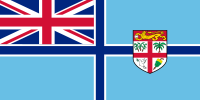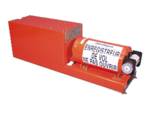- Civil Aviation Authority of the Fiji Islands
-
Civil Aviation Authority of the Fiji Islands 
Agency overview Formed 1999 [1] Jurisdiction Government of Fiji Headquarters Nadi Airport Minister responsible Voreqe Bainimarama, Minister for Foreign Affairs, International Co-operation and Civil Aviation Agency executives Ernest Dutta, Chairman
Netava Waqa, Chief ExecutiveParent agency Ministry of Foreign Affairs, International Co-operation and Civil Aviation Website www.caafi.org.fj The Civil Aviation Authority of the Fiji Islands (CAAFI) is the Aviation Authority in the Republic of the Fiji Islands and is responsible for discharging functions on behalf of the Government of Fiji under the States responsibility to the Convention on International Civil Aviation, also known as the Chicago Convention on International Civil Aviation Organization (ICAO). CAAFI regulates the activities of airport operators, air traffic control and air navigation service providers, airline operators, pilots and air traffic controllers, aircraft engineers, technicians, airports, airline contracting organisations and international air cargo operators in Fiji.
Contents
Vision
To be a model aviation regulator [2]
Mission
To promote effective aviation safety and security in the Fiji Islands and the region.[3]
Corporate Values
The Authority strives to reflect certain key values as the characteristics of the people who are the CAAFI team and equally for the organization as a whole by professionalism, accountability, commitment, and integrity in our conduct.[4]
ISO 9001 Certification
The Civil Aviation Authority of the Fiji Islands was ISO certified in July 2008 following a successful audit by Bureau Veritas, international auditors for ISO certification.[5]
History of the 1999 CAAF Reform
Background to Reform [6]
The reform of the Civil Aviation Authority of Fiji (CAAF) is a case which illustrates the impact of both political and trade union activities on the reform process. At the time of its reorganisation in 1999, its employees were members of the Fiji Public Service Association (FPSA). Many of the CAAF workers were opposed to the restructuring plans and the job losses that were a central part of the reform.
The CAAF was a statutory body established by the CAAF Act of 1979. Apart from providing regulatory oversight for domestic civil aviation and fulfilling international air safety obligations, it also owned and managed Nadi International Airport, as well as managing the Nausori Airport near Suva and the 23 small domestic airports located on many islands with low populations. In addition, it provided aviation support services to the region.
The CAAF functioned like a government department, but had a mixture of statutory responsibilities and commercial obligations. Effectively, it was a referee and a player in its own game. For the 20 years prior to the restructuring, it had been making annual profits. This was largely because its annual revenue growth was directly linked to the expansion of the international tourism industry in Fiji. Income was derived from landing and parking fees, air navigation charges, passenger service charges, terminal building concessions and rentals, fuel concessions, and the sale of excess power. It was exempt from income tax until the reform. Only minor investments were made into infrastructure. It received heavy financial assistance in the form of an annual government grant to run Nausori airport and the other loss-making airports.
Yet the government realised that the CAAF was inefficient, overstaffed and overburdened by bureaucracy. Its staff members' unions were in constant dispute with the management and the unions strongly resisted any changes to work practices. Two reviews of the CAAF had recommended non-core activities be divested to other organisations. In the late 1990s, processes were introduced to improve efficiency through a continuous quality improvement programme.
Division into Statutory Authority and Company [6]
In April 1997, the then Minister for Public Enterprises, Isimeli Bose announced that the CAAF was to be declared a "commercial statutory authority" and, in May, he said it would be reorganised pursuant to provisions of the public enterprise reform legislation. Subsequently, a reorganization charter was prepared. The principal objective of the reorganization was to increase the CAAF's efficiency and rate of return on assets, while at the same time providing an efficient regulatory function that meets international civil aviation standards (MCICP 1998c).
The reorganisation, facilitated by the Civil Aviation Reform Act 1999, involved separating the CAAF's regulatory role from its commercial operations. The commercial responsibilities and assets were transferred to a new company, Airports Fiji Ltd (AFL), which was established as a "government commercial company". It was incorporated under the Companies Act and required to operate along commercial lines, with clearly defined profitability targets and with new terms and conditions of employment. The main functions prescribed were the provision of air traffic management in Fiji and its flight information region; the management of airport commercial assets (the aerodromes, terminal buildings, commercial properties and infrastructure necessary for commercial activities); and the administration and management of airports as commercial businesses.
The CAAF's regulatory role was given to a newly-formed regulatory organisation called the Civil Aviation Authority of the Fiji Islands (CAAFI). The CAAFI's functions, as provided under the Civil Aviation Reform Act, include civil aviation regulation and international civil aviation obligations, along with safety oversight and safety education responsibilities for all airports, airlines, airport operations, and personnel. It oversees the activities of airport operators, air traffic control and air navigation service providers, and aircraft operators. It also has the responsibility for disposing of assets not required by AFL and for managing a housing estate (with over 150 residential sites) and other properties. In addition, it has a 51 percent shareholding in Air Terminal Services (Fiji) Ltd which provides ground handling services, including passenger handling, aircraft engineering, and in-flight catering. The implementation of the reform occurred in early April 1999, during the campaign for the May 1999 national elections. The approach adopted to transfer staff from CAAF to the two new organisations resulted in chaos. CAAF staff were terminated and paid their retirement gratuity and recreation leave entitlements. Many excess CAAF employees were offered redundancy packages and resigned.
Current Structure of CAAFI
Air Safety Department [7]
The department deals with flight operations and airworthiness matters such as:
- The regulation of commercial air transport and general aviation
- The provision of facilities for the examination, flight-testing and licensing of applicants for flight and ground crew licenses and ratings
- The monitoring of training and operational standards
- Ensuring that all flight operations are conducted in accordance with the Air Navigation Regulations and in conformity with ICAO standards
- Providing specialist advice when liasing with other units of CAAFI
- The maintenance of a dangerous goods control system
- The provision and maintenance of a flight safety oversight program that provides surveillance in accordance with ICAO standardsGround Safety Department [8]
The department is responsible for Aviation Regulatory Services, Aviation Standards and Aviation Safety Compliance on:
- Regulation of airport, air traffic services (ATS), air navigation services (ANS) and aeronautical information service activities in conformity with ICAO Standards
- Provision of standards documents on air traffic service personnel licensing, air traffic services, air navigation services and airports
- Licensing of personnel for the provision of air traffic services and air navigation services
- Co-ordinating and liasing with ICAO on matters relating to airports/ATS/ANS
- Monitoring airport/ATS/ANS incidents and making available analysis/feedback to the stakeholders
- Amendments to Regulations as necessary, based on international developments
- Encouraging a greater acceptance by the aviation industry of a safety culture through safety educational programs and trainingAviation Safety, Security and Facilitation Department [9]
The department deals with aviation security, facilitation and rescue and fire fighting services on following matters:
- Policy formulation and control of Programmes and Services
- Oversighting the implementation of National Programmes
- Evaluations and approvals of airports and airline operators Programmes for the purpose of issues of licences, certificates and permits
- Oversighting the implementations of airports and airline operators programmes,
- Inspections and surveys of Government and private airports for licensing purposes
- Monitoring of training, safety and security standards
- Conducting investigations into breaches or incidents
- Providing timely reports to the Board, Government and others
- Promoting safety and security in aviationCorporate Support Department [10]
The department provides corporate support services such as:
- Developing and implementing business plans after consultations and inputs from all departments
- Ensuring the Authority has a sound financial base and funding
- Managing the non-core business including the housing estate
- Providing statutory and secretarial advice and support to the Board. Ensuring Board decisions are implemented
- Ensuring submission of reports on time to appropriate authorities
- Ensuring that a process-based quality management system is implemented for CAAFI
- Provide an effective human resource and industrial relations system
- Ensure an effective administrative, legal and other support services are readily available
- Manage Authority's risks including insurance liabilities
- The provision of a co-ordinated incident and occurrence reporting system including subsequent investigation and the disseminating of safety information
- The provision of a confidential aviation incident reporting system
- Aviation Quality Database management.ANR Batch 1 (2003) Amendment
In 2003, Cabinet approved the promulgation of the Air Navigation (Amendment) Regulations 2003. Cabinet based its decision on a submission by the Minister for Transport and Civil Aviation, Josefa Vosanibola, who said that new regulations were needed to cater for changes in the aviation industry. “The aviation industry has gone through rapid changes in the last few years to respond to the needs of the market,” Mr Vosanibola said. He said the services that were normally provided by a state authority had been divided up among various corporations to bring about efficiency in the industry. The Minister said this division of responsibilities among profit making corporations required government to enact appropriate legislation to ensure that the safety of civil aviation was not compromised by commercial considerations. “The amendments also cover operational, safety and health issues arising from the acquisition of larger aircraft by Air Pacific,” he said. These included the manning of emergency doors on twin deck aircraft, and the need to ensure that the crew on these aircraft had adequate rest. Mr Vosanibola said the amended Regulations also return to CAAFI (Civil Aviation Authority of the Fiji Islands) some regulatory powers that were inadvertently passed on to Airports Fiji Limited by the Civil Aviation Reform Act, 1999. A total of 49 Regulations were amended to comply with safety standards and recommended practices introduced by the ICAO (International Civil Aviation Organization). These included Certification of Service Providers; Regulatory Functions; Airworthiness of Aircraft; Licensing; and Flight Operations and Rules of the Air. A transition period of six months from the date of promulgation was provided to allow stakeholders to comply with the amended Regulations.[11]
References
- ^ "Civil Aviation Reform in Fiji" (PDF). ICAO. 30 August – 03 September 1999. http://www.icao.int/icao/en/ro/apac/apanpirg10/ip2.pdf. Retrieved 2009-05-30.
- ^ "CAAFI Vision". CAAFI. 2005. http://www.caafi.org.fj/index.cfm?si=main.dept&cmd=corp. Retrieved 2009-06-01.[dead link]
- ^ "CAAFI Mission". CAAFI. 2005. http://www.caafi.org.fj/index.cfm?si=main.dept&cmd=corp. Retrieved 2009-06-01.[dead link]
- ^ "CAAFI Corporate Values". CAAFI. 2005. http://www.caafi.org.fj/index.cfm?si=main.dept&cmd=corp. Retrieved 2009-06-01.[dead link]
- ^ "Daily Post News Article - CAAFI ISO Certification". Daily Post. 2008. http://www.fijidailypost.com/news.php?section=1&fijidailynews=17438. Retrieved 2009-06-01.
- ^ a b "Public Enterprise Reform in Fiji" (PDF). Asia Journal of Public Administration. http://sunzi1.lib.hku.hk/hkjo/view/50/5000057.pdf. Retrieved 2009-05-30.
- ^ "Function of the Air Safety Department". CAAFI. 2005. http://www.caafi.org.fj/index.cfm?si=main.dept&cmd=air. Retrieved 2009-06-01.[dead link]
- ^ "Function of the Ground Safety Department". CAAFI. 2005. http://www.caafi.org.fj/index.cfm?si=main.dept&cmd=ground. Retrieved 2009-06-01.[dead link]
- ^ "Function of the Aviation Safety, Security and Facilitation Department". CAAFI. 2005. http://www.caafi.org.fj/index.cfm?si=main.dept&cmd=avisafe. Retrieved 2009-06-01.[dead link]
- ^ "Function of the Corporate Support Department". CAAFI. 2005. http://www.caafi.org.fj/index.cfm?si=main.dept&cmd=corp. Retrieved 2009-06-01.[dead link]
- ^ "CAP174 ANR Batch 1 Amendment". Fiji Govt. 2003. http://www.fiji.gov.fj/cgi-bin/cms/exec/view.cgi/52/1650. Retrieved 2009-06-05.
External links
- CAAFI Website
- CAAFI Organisation Structure
- Ministry of Foreign Affairs, International Co-operation and Civil Aviation
- Fiji Aircraft Register
- Air Navigation Batch 1 (2003) Regulations
Aviation accident and incident investigation agencies Africa 
Asia Europe North America Oceania South America Categories:- Civil aviation authorities
- Transport in Fiji
- Organizations investigating aviation accidents and incidents
Wikimedia Foundation. 2010.
